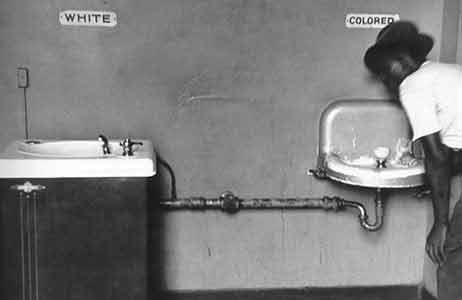In the Plessy vs. Ferguson Case, the supreme court ruled that the if facilities were separate but equal, it didn't violate the 14th amendment. This rule was often broken as you can see in the picture below.

Jim Crow wasn't an actual person, but "he" affected the lives of millions of people. The laws were named after a popular 19th century minstrel song that stereo typed African Americans. A white minstrel performer named Thomas Dartmouth "Daddy" Rice blackened his face and danced a silly jig while singing the song "Jump Jim Crow"

Lyrics to Jump Jim Crow and the audio clip from the fiddle music he used.
http://memory.loc.gov/afc/afcreed/130/13035a39.mp3
Come listen all you galls and boys,
I'm going to sing a little song,
My name is Jim Crow.Chorus: Weel about and turn about and do jis so
Eb'ry time I weel about I jump Jim Crow.
I went down to de river, I didn't mean to stay,
But there I see so many gals, I couldn't get away.
I'm rorer on de fiddle, an' down in ole Virginny,
Dey say I play de skientific, like massa Paganini.
I cut so many munky shines, I dance de galloppade;
An' w'en I done, I res' my head, on shubble, hoe or spade.
I met Miss Dina Scrub one day, I gib her sich a buss;
An' den she turn an' slap my face, an' make a mighty fuss.
De udder gals dey 'gin to fight, I tel'd dem wait a bit;
I'd hab dem all, jis one by one, as I tourt fit.
I wip de lion ob de west, I eat de alligator;
I put more water in my mouf, den boil ten load ob 'tator.
De way dey bake de hoe cake, Virginny nebber tire;
Dey put de doe upon de foot, an' stick 'em in de fire
http://memory.loc.gov/afc/afcreed/130/13035a39.mp3
I'm going to sing a little song,
My name is Jim Crow.Chorus: Weel about and turn about and do jis so
Eb'ry time I weel about I jump Jim Crow.
I went down to de river, I didn't mean to stay,
But there I see so many gals, I couldn't get away.
I'm rorer on de fiddle, an' down in ole Virginny,
Dey say I play de skientific, like massa Paganini.
I cut so many munky shines, I dance de galloppade;
An' w'en I done, I res' my head, on shubble, hoe or spade.
I met Miss Dina Scrub one day, I gib her sich a buss;
An' den she turn an' slap my face, an' make a mighty fuss.
De udder gals dey 'gin to fight, I tel'd dem wait a bit;
I'd hab dem all, jis one by one, as I tourt fit.
I wip de lion ob de west, I eat de alligator;
I put more water in my mouf, den boil ten load ob 'tator.
De way dey bake de hoe cake, Virginny nebber tire;
Dey put de doe upon de foot, an' stick 'em in de fire
Jim Crow Laws discriminated against African Americans with attendance in public schools, restaurants, hotels, railway cars and other public facilities. When Rosa Parks wouldn't give up her seat to a white man she was arrested for breaking a Jim Crow Law. In the drawing below an African American man is being kicked out of his seat by a white man. Rosa Parks in a similar scenario refused to move and got arrested for it.
This is an image from a cafe in Durham, North Carolina in 1940. It has separate doors and lunch rooms that split apart whites and blacks. Many businesses in the south had separate facilities to serve each race.

Artist Statement
Our quilt piece has the “Jim Crow Laws” written on the top
with two signs hanging off it to show our topic. The signs have the words
blacks and whites written on them to represent segregation between the two
races. The black sign is broken because the African Americans had less than the
whites and the quality of the African American’s facilities was very poor compared
to the whites. In the middle there is a tree with crows
perched on the branches to show the “Crow” part of Jim Crow as a symbol. Below
there are the words “Separate, but equal” from the Plessy vs. Ferguson Case
where the Supreme Court ruled that the separate train cars for each race wouldn’t
violate the 14th amendment as long as they were equal. It is torn
apart because the facilities were separated, but not equal. Jim Crow Laws have
a lasting effect on people of color and racism that is still present today. The
history of racism in the U.S., including Jim Crow Laws, links communities of
color to poverty and ongoing racism. In Portland, Oregon schools like Jefferson
have some of the lowest test scores, 53% of the students are African American
and the neighborhood has the highest concentration of poverty in the city.

No comments:
Post a Comment